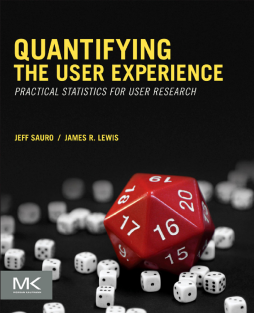
Additional Information
Book Details
Abstract
Quantifying the User Experience: Practical Statistics for User Research offers a practical guide for using statistics to solve quantitative problems in user research. Many designers and researchers view usability and design as qualitative activities, which do not require attention to formulas and numbers. However, usability practitioners and user researchers are increasingly expected to quantify the benefits of their efforts. The impact of good and bad designs can be quantified in terms of conversions, completion rates, completion times, perceived satisfaction, recommendations, and sales.
The book discusses ways to quantify user research; summarize data and compute margins of error; determine appropriate samples sizes; standardize usability questionnaires; and settle controversies in measurement and statistics. Each chapter concludes with a list of key points and references. Most chapters also include a set of problems and answers that enable readers to test their understanding of the material. This book is a valuable resource for those engaged in measuring the behavior and attitudes of people during their interaction with interfaces.
- Provides practical guidance on solving usability testing problems with statistics for any project, including those using Six Sigma practices
- Show practitioners which test to use, why they work, best practices in application, along with easy-to-use excel formulas and web-calculators for analyzing data
- Recommends ways for practitioners to communicate results to stakeholders in plain English
-
Resources and tools available at the authors’ site: http://www.measuringu.com/
"Quantifying the User Experience will make a terrific textbook for any series of UX research courses…I highly recommend this book to anyone who wants to integrate quantitative data into their UX practice."--Technical Communication, May 2013 "…as a whole, it provides a pragmatic approach to quantifying UX, without oversimplifying or claiming too much. It delivers what it promises. This book is valuable for both practitioners and students, in virtually any discipline. It can help psychologists transfer their statistical knowledge to UX practice, practitioners quickly assess their envisioned design and analysis, engineers demystify UX, and students appreciate UX’s merits."--ComputingReviews.com, March 19, 2013 "The most unique contributions of this book are the logic and practicality used to describe the appropriate application of those measures…Sauro and Lewis strike a perfect balance between the complexity of statistical theory and the simplicity of applying statistics practically. Whether you wish to delve deeper into the enduring controversies in statistics, or simply wish to understand the difference between a t-test and Chi-square, you will find your answer in this book. Quantifying the User Experience is an invaluable resource for those who are conducting user research in industry."--User Experience, Vol. 13, Issue 1, 1st Quarter "Written in a conversational style for those who measure behavior and attitudes of people as they interact with technology interfaces, this guide walks readers through common questions and problems encountered when conducting, analyzing, and reporting on user research projects using statistics, such as problems related to estimates and confidence intervals, sample sizes, and standardized usability questionnaires. For readers with varied backgrounds in statistics, the book includes discussion of concepts as necessary and gives examples from real user research studies. The book begins with a background chapter overviewing common ways to quantify user research and a review of fundamental statistical concepts. The material provides enough detail in its formulas and examples to let readers do all computations in Excel, and a website offers an Excel calculator for purchase created by the authors, which performs all the computations covered in the book. An appendix offers a crash course on fundamental statistical concepts."--Reference and Research Book News, August 2012, page 186-7
